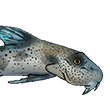| Scientific Name | Glyptothorax anamalaiensis Silas, 1952 |
| Common Name | |
| Type Locality | Stream in Anamalai Hills, Western Ghats, India. |
| Pronunciation | Gleep toe thor axe - aana malay ensis |
| Etymology | The generic name comes from the Greek glyptos, meaning carved, and thorax, meaning breastplate (or the part of the body covered by it), in reference to the folds of skin comprising the thoracic adhesive apparatus. Named after its type locality, the Anamalai Hills. |
| Identification | Sisorid catfishes of the genus Glyptothorax Blyth are benthic inhabitants of torrential waters of rivers and streams in montane and submontane parts of tropical Asia. The members of the genus are adapted to attach themselves to rocks and boulders against strong currents by means of a thoracic adhesive apparatus comprising grooves and folded pleats of skin parallel or oblique to the longitudinal axis of the body. The genus has a wide distribution, ranging from Turkey and Syria in the west, to India and China in the east, and extending further southeastward to Indonesia. With 84 nominal species, Glyptothorax are the most speciose genus of catfishes in Asia (Eschmeyer et al., 1998, Ng, 2005); 67 species were treated as valid by Thomson & Page (2006). Glyptothorax anamalaiensis can be differentiated from congeners by having the paired fins plaited below ventrally and a body with three transverse white bands. |
| Sexing | Not known. |
| General Remarks | It is very likely that this species has not been exported for the trade as yet but general care will be very similar to that of other Glyptothorax species. |
| Distribution | Ponnani drainage, Western Ghats, peninsular India Indian waters, Kerala State Waters, Bharathappuzha (click on these areas to find other species found there) Indian waters, Western Ghats Waters (click on these areas to find other species found there) Login to view the map. |
| IUCN Red List Category | Endangered , range map and more is available on the IUCN species page. Last assessed 2010. |
| Other Parameters | The water should be cool and heavily oxygenated with a good flow as these fish occur in hill streams. Anything above 25 C will hamper long term survival as these fish tend to burn away at higher temperatures. |
| Feeding | Is known to take only live food like blood worms, frozen brine shrimp etc. Spot feeding will help in case tank mates are voracious feeders. User data. |
| Furniture | Fine sand for the bottom and smooth pebbles / rocks. |
| Compatibility | A peaceful species suitable for a hillstream biotope. |
| Suggested Tankmates | Cyprinids like Barilius and Danios and Balitorine loaches like Homaloptera species. |
| Breeding | Unreported in the aquarium. |
| Breeding Reports | There is no breeding report. |
| Reference | Journal of the Bombay Natural History Society v. 50 (pt 2) [1951], pp 370. |
| Registered Keepers | There are 4 registered keepers, view all "my cats" data. |
| Wishlists | Love this species? Click the heart to add it to your wish list. There is but a single wish to keep this species, see who wants what. |
| Spotters | Spotted this species somewhere? Click the binoculars! There are 3 records of this fish being seen, view them all. |
| Forum BBCode | |
| Search for G. anamalaiensis | |
| Look up G. anamalaiensis on AquaticRepublic.com | |
 | Look up G. anamalaiensis on Fishbase |
 | Look up G. anamalaiensis on Encyclopedia of Life |
 | Look up G. anamalaiensis on Global Biodiversity Information Facility |
| LFS label creator ARN ref:1.20.170.2359 | |
| Last Update | 2025 Jan 01 12:24 (species record created: 2009 Nov 07 04:46) |





/siluriformes/sisoridae/glyptothorax/anamalaiensis/1.jpg)
/siluriformes/sisoridae/glyptothorax/anamalaiensis/2.jpg)
/siluriformes/sisoridae/glyptothorax/anamalaiensis/3.jpg)
/siluriformes/sisoridae/glyptothorax/anamalaiensis/4.jpg)
/siluriformes/sisoridae/glyptothorax/anamalaiensis/5.jpg)
/siluriformes/sisoridae/glyptothorax/anamalaiensis/6.jpg)
/siluriformes/sisoridae/glyptothorax/anamalaiensis/7.jpg)
